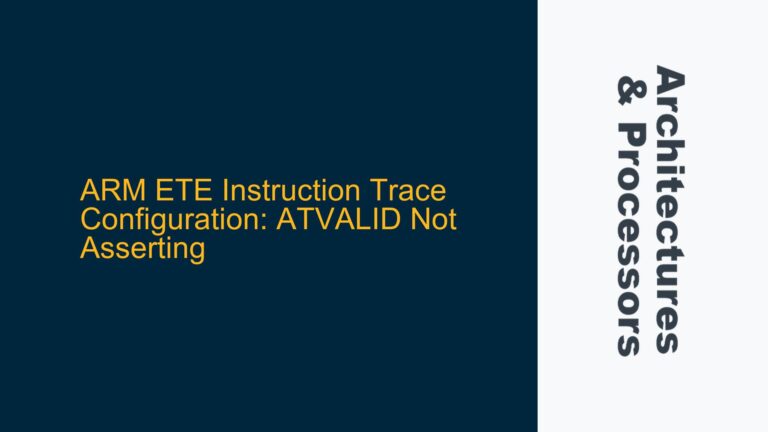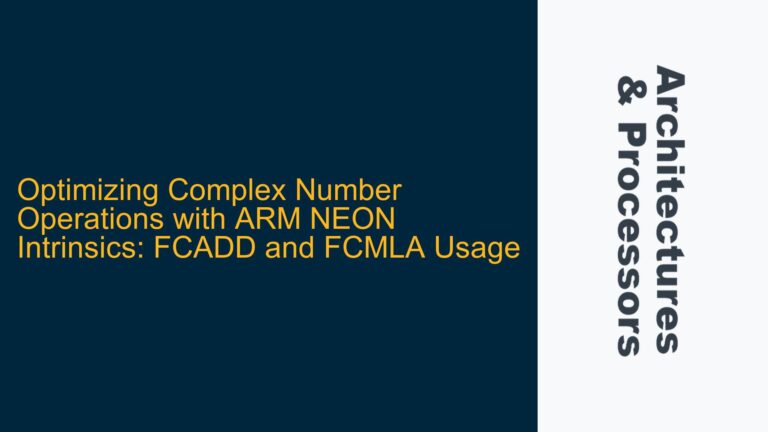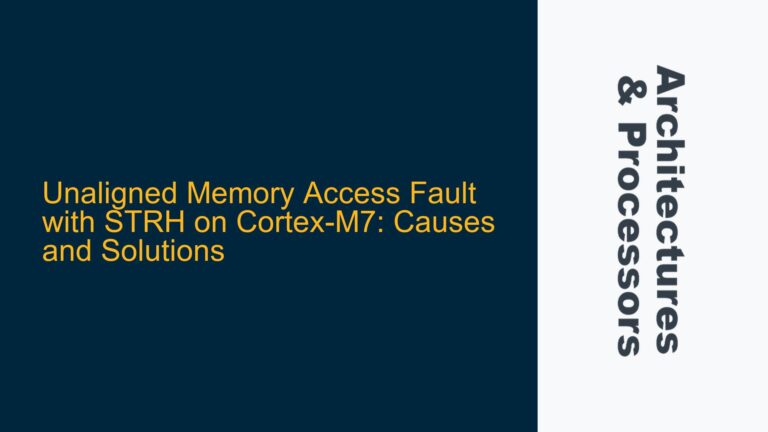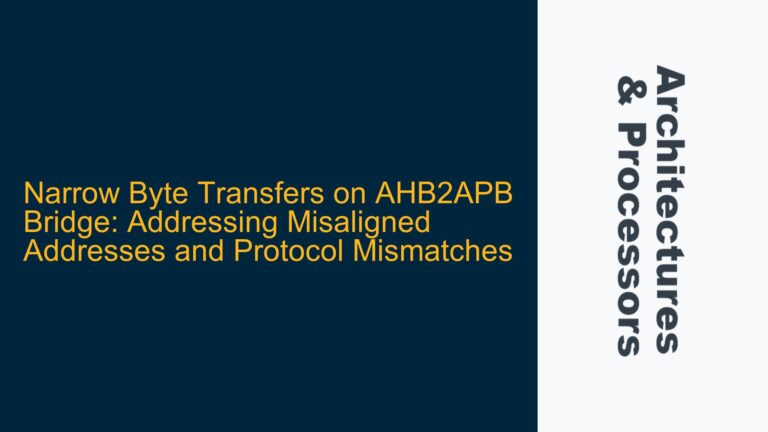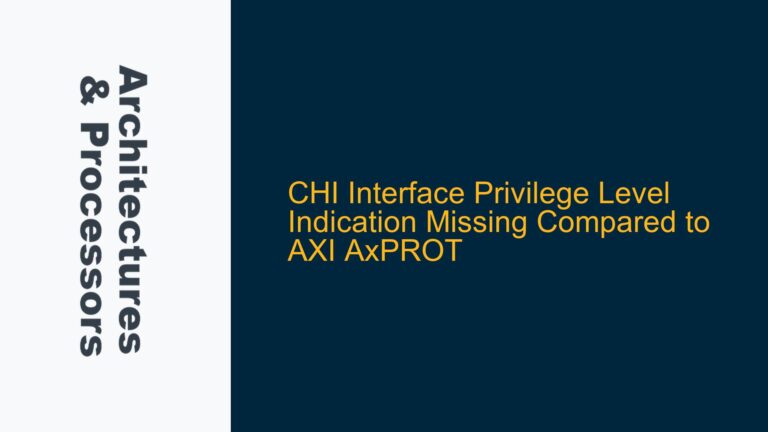ARM Cortex-A53 FIQ Configuration Challenges at EL1
Configuring Fast Interrupt Requests (FIQs) at Exception Level 1 (EL1) on an ARM Cortex-A53 processor with a Generic Interrupt Controller version 2 (GICv2) presents a unique set of challenges, particularly when operating within the Linux kernel environment. The primary issue revolves around the lack of direct support for FIQs in the mainline Linux kernel for ARMv8-A architectures, despite the availability of such support in ARMv7-A. This discrepancy necessitates a deeper understanding of the ARM architecture, the role of exception levels, and the interaction between the processor and the interrupt controller.
The ARM Cortex-A53 processor, being a part of the ARMv8-A family, introduces a more complex exception handling mechanism compared to its ARMv7-A predecessors. The ARMv8-A architecture defines four exception levels (EL0 to EL3), with EL1 typically being the level at which the operating system kernel runs. FIQs, which are designed to provide low-latency interrupt handling, are traditionally routed to the secure world (EL3) in ARMv8-A systems. However, there are scenarios where configuring an FIQ at EL1 is desirable, such as in real-time applications where minimizing interrupt latency is critical.
The GICv2, which is commonly used in conjunction with the Cortex-A53, plays a crucial role in managing interrupts. It provides a mechanism to route interrupts to either IRQ or FIQ lines, depending on the configuration. However, the Linux kernel’s support for FIQs in ARMv8-A is limited, and the default behavior is to route FIQs to the secure world. This limitation complicates the process of configuring an FIQ at EL1, as it requires either modifying the kernel or leveraging alternative mechanisms such as pseudo-NMIs (Non-Maskable Interrupts) in the case of GICv3.
Memory Management and Exception Level Interactions in ARMv8-A
The configuration of FIQs at EL1 on an ARM Cortex-A53 processor with GICv2 is influenced by several factors, including the memory management system, the interaction between different exception levels, and the specific capabilities of the GICv2. One of the primary causes of the difficulty in configuring FIQs at EL1 is the architectural design of ARMv8-A, which prioritizes security by routing FIQs to the secure world (EL3) by default. This design choice is intended to ensure that critical interrupts are handled in a secure environment, but it complicates the process of handling FIQs at EL1.
Another contributing factor is the limited support for FIQs in the mainline Linux kernel for ARMv8-A. While the ARMv7-A architecture has well-established support for FIQs within the Linux kernel, the ARMv8-A architecture does not provide the same level of support. This lack of support is partly due to the increased complexity of the ARMv8-A exception handling model, which introduces additional layers of abstraction and security considerations. As a result, developers seeking to configure FIQs at EL1 must either modify the kernel or find alternative solutions.
The GICv2’s role in interrupt routing is also a critical factor. The GICv2 allows interrupts to be configured as either IRQs or FIQs, but the default behavior in ARMv8-A systems is to route FIQs to the secure world. This behavior is controlled by the GIC’s configuration registers, which determine how interrupts are routed to the processor. In the case of the Cortex-A53, the GICv2’s configuration must be carefully managed to ensure that FIQs are routed to EL1 rather than EL3. This requires a deep understanding of the GICv2’s register set and the ability to modify the kernel’s interrupt handling code.
Additionally, the interaction between different exception levels can complicate the configuration of FIQs at EL1. In ARMv8-A, each exception level has its own set of registers and memory mappings, and transitions between exception levels involve context switching and potential changes to the memory management configuration. This complexity can lead to subtle issues when attempting to configure FIQs at EL1, particularly if the system is also running software at higher exception levels (e.g., a hypervisor at EL2 or secure monitor at EL3).
Implementing FIQ Handlers and Managing Interrupt Routing in Linux
To configure an FIQ at EL1 on an ARM Cortex-A53 processor with GICv2, several steps must be taken to ensure that the interrupt is correctly routed and handled. The following sections outline the necessary steps, including modifications to the Linux kernel, configuration of the GICv2, and management of exception level interactions.
Modifying the Linux Kernel for FIQ Support
The first step in configuring an FIQ at EL1 is to modify the Linux kernel to support FIQs. As mentioned earlier, the mainline Linux kernel for ARMv8-A does not provide direct support for FIQs, so custom modifications are required. These modifications typically involve adding an FIQ handler to the kernel’s interrupt handling code and ensuring that the FIQ is correctly routed to EL1.
The FIQ handler must be implemented in assembly language to ensure low-latency handling of the interrupt. The handler should be designed to perform the minimum necessary processing before returning control to the interrupted context. This may involve saving and restoring registers, acknowledging the interrupt in the GICv2, and performing any necessary context switching.
In addition to implementing the FIQ handler, the kernel’s interrupt handling code must be modified to route the FIQ to EL1. This involves configuring the GICv2’s registers to ensure that the FIQ is routed to the correct exception level. The specific registers that need to be modified depend on the GICv2’s implementation, but typically include the GICD_IGROUPR and GICD_ISENABLER registers, which control the grouping and enabling of interrupts.
Configuring the GICv2 for FIQ Routing
The GICv2 must be configured to route the desired interrupt as an FIQ to EL1. This involves setting the appropriate bits in the GICv2’s configuration registers to ensure that the interrupt is recognized as an FIQ and routed to the correct exception level.
The GICD_IGROUPR register is used to configure the group of each interrupt. In GICv2, interrupts can be configured as either Group 0 (secure) or Group 1 (non-secure). To route an interrupt as an FIQ to EL1, it must be configured as a Group 0 interrupt. This is because FIQs are typically routed to the secure world (EL3) by default, and configuring the interrupt as a Group 0 interrupt ensures that it is handled as an FIQ.
The GICD_ISENABLER register is used to enable or disable individual interrupts. To ensure that the FIQ is recognized by the processor, the corresponding bit in the GICD_ISENABLER register must be set. This enables the interrupt and allows it to be routed to the processor.
In addition to configuring the GICv2’s registers, the processor’s interrupt handling code must be modified to ensure that the FIQ is correctly acknowledged and handled. This typically involves adding code to the kernel’s interrupt handling routine to acknowledge the FIQ in the GICv2 and to call the appropriate FIQ handler.
Managing Exception Level Interactions
The interaction between different exception levels can complicate the configuration of FIQs at EL1. In ARMv8-A, each exception level has its own set of registers and memory mappings, and transitions between exception levels involve context switching and potential changes to the memory management configuration.
To ensure that the FIQ is correctly handled at EL1, it is important to manage the transitions between exception levels carefully. This may involve modifying the secure monitor code (if running at EL3) or the hypervisor code (if running at EL2) to ensure that the FIQ is correctly routed to EL1.
In some cases, it may be necessary to modify the memory management configuration to ensure that the FIQ handler has access to the necessary resources. This may involve configuring the MMU (Memory Management Unit) to map the necessary memory regions or modifying the page tables to ensure that the FIQ handler can access the required data.
Alternative Solutions: Pseudo-NMIs in GICv3
In cases where modifying the Linux kernel and configuring the GICv2 is not feasible, an alternative solution is to use pseudo-NMIs (Non-Maskable Interrupts) in GICv3. Pseudo-NMIs provide a mechanism for handling high-priority interrupts with low latency, similar to FIQs, but without the need for extensive modifications to the kernel.
Pseudo-NMIs are configured using the GICv3’s priority masking feature, which allows interrupts to be masked based on their priority. By configuring a high-priority interrupt as a pseudo-NMI, it is possible to achieve low-latency interrupt handling without the need for FIQ support in the kernel.
To configure a pseudo-NMI in GICv3, the GICR_IPRIORITYR register must be configured to set the priority of the interrupt. The interrupt must then be enabled in the GICD_ISENABLER register, and the processor’s interrupt handling code must be modified to handle the pseudo-NMI.
Conclusion
Configuring an FIQ at EL1 on an ARM Cortex-A53 processor with GICv2 is a complex task that requires a deep understanding of the ARMv8-A architecture, the GICv2 interrupt controller, and the Linux kernel’s interrupt handling mechanisms. By carefully modifying the kernel, configuring the GICv2, and managing exception level interactions, it is possible to achieve low-latency interrupt handling at EL1. In cases where modifying the kernel is not feasible, alternative solutions such as pseudo-NMIs in GICv3 can provide a viable alternative.
The process of configuring FIQs at EL1 involves several steps, including modifying the Linux kernel, configuring the GICv2, and managing exception level interactions. Each of these steps requires careful consideration and a thorough understanding of the underlying hardware and software components. By following the steps outlined in this guide, developers can successfully configure FIQs at EL1 on an ARM Cortex-A53 processor with GICv2, enabling low-latency interrupt handling for real-time applications.

